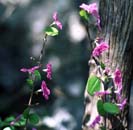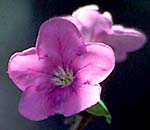 |
QUICK SEARCH
MO PROJECTS:
Africa
Asia/Pacific
Mesoamerica
North America
South America
General Taxonomy
Photo Essays
Training in Latin
America
MO RESEARCH:
Wm. L. Brown Center
Bryology
GIS
Graduate Studies
Research Experiences
for Undergraduates
Imaging Lab
Library
MBG Press
Publications
Climate Change
Catalog Fossil Plants
MO DATABASES:
W³MOST
Image Index
Rare Books
Angiosperm
Phylogeny
Res Botanica
All Databases
INFORMATION:
What's New?
People at MO
Visitor's Guide
Herbarium
Jobs & Fellowships
Symposium
Research Links
Site Map
Search
|
Draft Treatments | Guidelines | Checklist | Citing | Editors The Cutting EdgeVolume VIII, Number 4, October 2001News and Notes | Recent Treatments | Leaps and Bounds | Germane Literature | Season's Pick SEASON'S PICK: Plocosperma buxifolium 
 This season's pick is thanks to Manual co-editor Nelson Zamora and his participation in the summer OTS Systematics course (led once more by the undaunted ecologist/taxonomist team of Brad Boyle and Robbin Moran) on their stay at Palo Verde. We first laid eyes on this perplexing and little known species almost 11 years ago, when Nelson brought in a sterile specimen (Zamora 1563--to our knowledge, the first Costa Rican collection), also from Palo Verde--all of the five currently known Costa Rican collections are from dry forest, limestone bluffs of Palo Verde and the nearby Lomas Barbudal. Nelson informs that knowledge of the existence of this species in Costa Rica goes back much further, at least to ca. 1984 when contemporary dean of Costa Rican dendrologists, Luis Poveda, pointed the plant out to him on a field trip to Palo Verde. Still, in 1990, we were intrigued, could not place it to family. A few weeks later parataxonomist Ulisis Chavarría brought in a fruiting specimen (Chavarrķa 193), which, for its comose seeds, made Apocynaceae or Asclepiadaceae seem more likely than our first estimates of Verbenaceae or related. Back then, before we were hooked on Internet, scan and digital camara technology, we eventually got a blurry, black and white fax of it to Asclepiadaceae and Nicaragua specialist, MO colleague Doug Stevens, who readily identified it as the problematic Plocosperma buxifolium Benth. of the problematic Loganiaceae. The species, relatively common and abundantly collected in Nicaragua, is now known from Mexico, Guatemala, Nicaragua and Costa Rica. Recently, with the break-up of Loganiaceae s. l. by way of molecular and other phylogenetic studies, (see, e.g., Backlund et al. [2000], as reported in the Edge 7(3): 4, July 2000) the species is generally considered, once again, to belong in its own monotypic family, Plocospermataceae. Currently its ordenal affinities are either undefined (see Backlund et al., loc. cit.) or somewhere within the Lamiales (see Stevens, P. F. 2001 and references therein). Flora of Nicaragua and our current Manual lists treat it in the Loganiaceae, s. l. Photo credits go to Nelson Zamora. |
© 1995-2025 Missouri Botanical Garden, All Rights Reserved
4344 Shaw Blvd.
St. Louis, MO 63110
(314) 577-5100
Technical Support